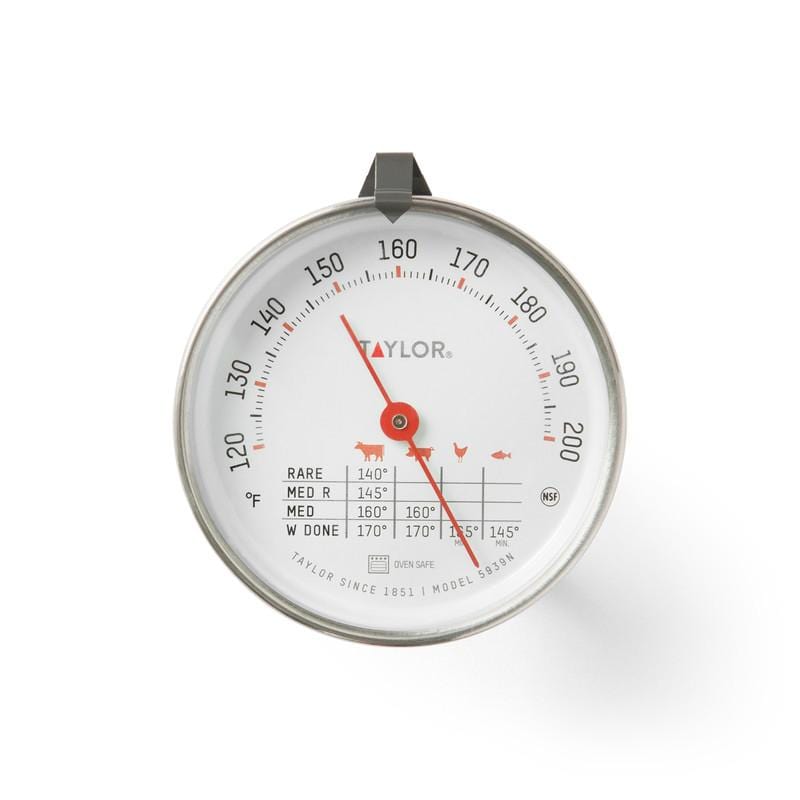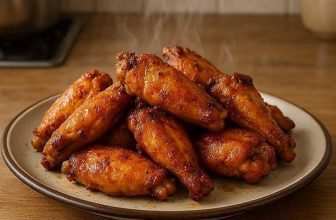How to Read a Meat Thermometer?

How to Read a Meat Thermometer? To read a meat thermometer, insert it into the thickest part of the meat and wait for the temperature to display. It’s important to know the correct temperature for the type of meat being cooked to ensure it is safe to eat.
Cooking meat to the correct temperature is crucial for both food safety and taste. A meat thermometer is an essential tool for any home cook or professional chef. It allows you to accurately measure the internal temperature of meat, ensuring it is cooked to the right temperature and safe to eat.
Different types of meat require different temperatures to be considered safe for consumption, so it’s important to know the correct temperature for the type of meat you are cooking. In this blog post, we will cover the basics of how to read a meat thermometer and provide some tips for using it effectively.

The Importance Of Meat Temperature
Meat temperature is crucial for both safety and flavor. By ensuring that your meat is cooked to the right temperature, you can avoid the risk of foodborne illnesses. It is important to prioritize safety when handling raw meat, as it can harbor harmful bacteria. Cooking meat to the recommended internal temperature kills these bacteria, reducing the risk of contamination. Additionally, proper cooking temperature also plays a role in the texture and flavor of the meat. Overcooking can result in a dry and tough texture while undercooking can leave the meat raw and potentially unsafe to eat. By using a meat thermometer, you can accurately measure the internal temperature and achieve the desired texture and flavor. Remember to insert the thermometer into the thickest part of the meat for an accurate reading.
:strip_icc()/Dial20Meat20Thermometer20in20Pork20Roast-cd5253f4f9034eb1b061deef306a3b00.jpg)
Types Of Meat Thermometers
There are three main types of meat thermometers: instant-read thermometers, dial thermometers, and smart thermometers. Instant-read thermometers provide quick temperature readings and are suitable for thin cuts of meat. Dial thermometers are inserted into the meat and display the temperature on a dial. They are ideal for thicker cuts of meat. Smart thermometers can be inserted into the meat and connected to a smartphone app to provide real-time temperature updates and alerts.
Calibrating Your Meat Thermometer
When calibrating your meat thermometer, you can use the ice water method. Fill a glass with ice, add cold water, and let it sit for a few minutes. Insert the thermometer into the ice water without touching the glass. The temperature should read 32°F (0°C). If it doesn’t, there’s an adjustment nut on the thermometer that can be used to correct the reading.
Another method is the boiling water method. Boil a pot of water and insert the thermometer into the boiling water without touching the bottom. The temperature should read 212°F (100°C). If it doesn’t, use the adjustment nut to correct the reading. These simple calibration methods ensure the accuracy of your meat thermometer.
Reading An Instant-read Thermometer
To read a meat thermometer, insert the probe into the thickest part of the meat without touching the bone. Wait for the temperature to stabilize, then read the dial or digital display. For safe consumption, make sure the temperature reaches the recommended level for the specific type of meat.
| Insertion Technique | Wait Time for Accuracy |
|---|---|
| Insert the thermometer stem into the thickest part of the meat, avoiding bones and fat. Make sure the stem doesn’t touch any bone or the pan. | Wait for a few seconds until the temperature reading stabilizes. The reading will increase or decrease until it reaches the actual temperature. |
| For thin cuts, insert the thermometer from the side to the center of the meat. For thicker cuts, insert it from the top. | For an accurate reading, wait for at least 15 seconds before taking the temperature again. |
| Always clean the thermometer after each use to avoid contamination. | For food safety, make sure to reach the minimum recommended internal temperature for different types of meat. |
Using A Dial Thermometer
To read a meat thermometer, use a dial thermometer by inserting it into the thickest part of the meat, away from bone and fat. Wait for a few seconds for the temperature to stabilize, then read the temperature on the dial.
Keep in mind the recommended temperature for the specific type of meat you are cooking.
| Proper Placement | Reading the Dial |
| Insert the thermometer deep into the meat. | Look at the temperature where the needle points. |
| Ensure it’s not touching bone for accurate reading. | Check the temperature quickly to avoid heat loss. |
Smart Thermometer Advantages
Smart meat thermometers offer convenient advantages for cooking enthusiasts. Remote monitoring allows you to keep an eye on the temperature from a distance. App integration enables seamless connectivity with your smartphone or other smart devices.
Temperature Guide For Different Meats
Discover how to accurately read a meat thermometer with our comprehensive temperature guide for different meats. Learn the proper temperatures for various types of meat, ensuring your meals are cooked to perfection every time. Whether you’re grilling, roasting, or searing, this guide will help you achieve optimal results.
| Meat Type | Temperature (°F) |
| Beef, Pork, Lamb | Cook to 145 for medium rare, and 160 for medium. |
| Poultry | Chicken: 165, Turkey: 165, Duck: 165. |
| Fish, Seafood | Cook until 145 for safety, until opaque and flakes easily. |
Troubleshooting Common Issues
Learn how to read a meat thermometer with these troubleshooting tips. Discover the best practices for accurate temperature readings, ensuring perfectly cooked meat every time.
| • Check the thermometer battery and replace it if necessary. | • Ensure the thermometer probe is fully inserted into the meat. |
| • Clean the thermometer stem before and after each use. | • Calibrate thermometer for accurate readings. |
Cleaning And Maintenance
After using a meat thermometer, it is crucial to properly clean and dry it to maintain accuracy and longevity. Use warm soapy water and a soft cloth to clean the thermometer, ensuring no residue remains. Store the thermometer in a protective case or sleeve to prevent damage and keep it clean. Proper storage in a dry and cool place helps to maintain its accuracy and functionality. Avoid exposing the thermometer to extreme temperatures or direct sunlight. By following these simple after-use care and storage best practices, you can ensure that your meat thermometer remains in optimal condition for accurate readings.

Meat Thermometer Alternatives
Explore meat thermometer alternatives for accurate readings. Opt for instant-read thermometers or probe thermometers for precise cooking results. Mastering these tools ensures perfectly cooked meats every time.
| The finger test involves touching different parts of your hand to gauge doneness. |
| For the cake tester method, insert it into the meat and feel the warmth. |
Tips For Perfect Meat Every Time
Properly cooked meat is essential for food safety and taste. One way to ensure that your meat is cooked to perfection is by using a meat thermometer. Here are some tips for using a meat thermometer:
- Insert the thermometer into the thickest part of the meat, making sure it doesn’t touch bone or fat.
- Wait for a few seconds until the temperature stabilizes.
- Check the temperature against a meat temperature chart to ensure it’s cooked to the desired level of doneness.
Another important aspect of cooking meat is letting it rest before serving. This allows the juices to redistribute and results in more tender and flavorful meat. As a general rule, let your meat rest for at least 5 minutes before cutting into it.
Consistent cooking practices are also key to achieving perfect meat every time. Make sure to preheat your oven or grill to the proper temperature and use a timer to avoid overcooking. With these tips, you’ll be able to master the art of cooking meat to perfection!
Frequently Asked Questions
How To Use A Classic Meat Thermometer?
To use a classic meat thermometer, insert it into the thickest part of the meat, avoiding any bones or fat. Ensure it’s not touching the bone or pan. Wait for the temperature to stabilize, then read the temperature on the display.
Clean and sanitize the thermometer after use.
What Should The Meat Thermometer Say?
The meat thermometer should read the recommended internal temperature for the type of meat being cooked. This ensures that the meat is cooked to a safe temperature, killing any harmful bacteria, and also prevents overcooking which can result in dry or tough meat.
Always refer to a reliable cooking temperature chart for the specific type of meat being cooked.
How To Tell If Meat Is Cooked With A Thermometer?
To tell if meat is cooked, insert a thermometer. Ensure it reaches the recommended internal temperature.
Do You Put The Meat Thermometer In While Cooking?
Yes, it is recommended to insert the meat thermometer while cooking to ensure accurate temperature readings.
Conclusion
Understanding how to read a meat thermometer is crucial for cooking perfect meals. By following the proper techniques, you can ensure food safety and achieve the desired level of doneness. Remember, accuracy is key when using a meat thermometer, so always double-check your readings for best results.
Master this skill to elevate your culinary game!






